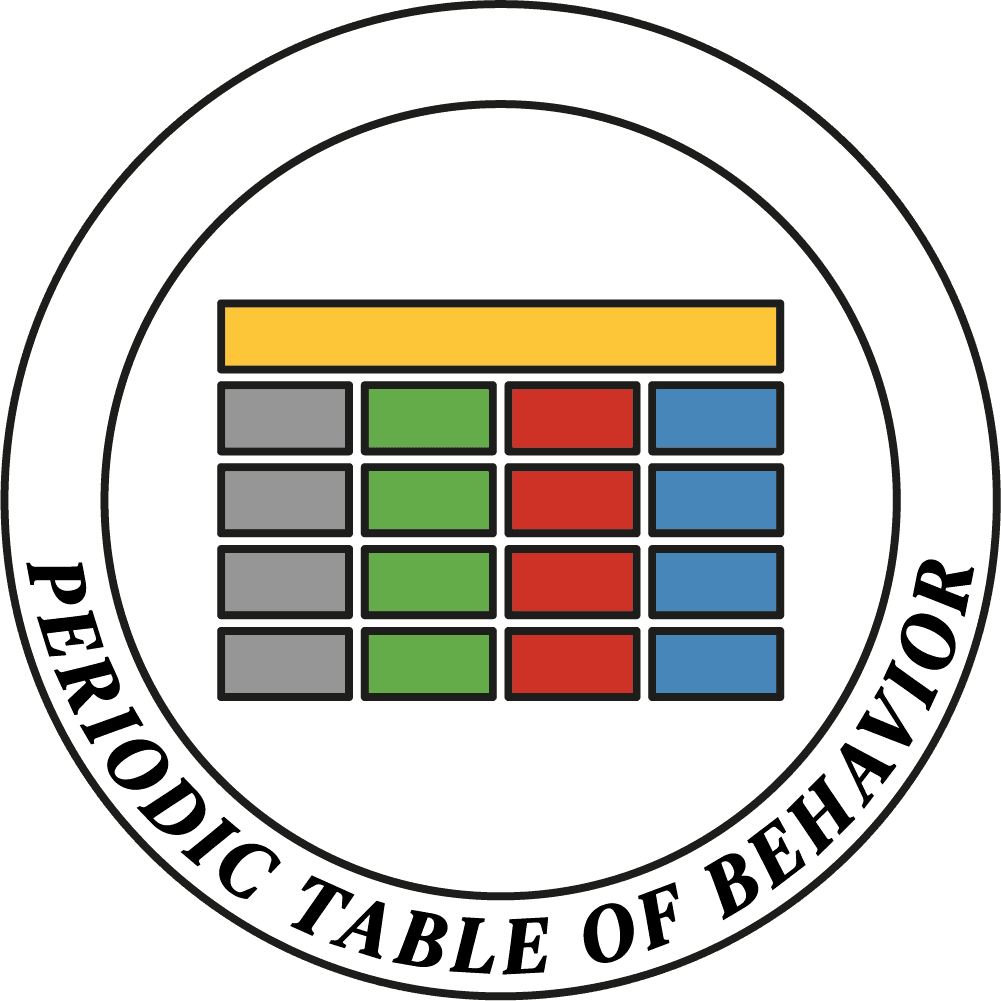The Periodic Table of Behavior (PTB) is UTOK’s comprehensive taxonomy of behavioral patterns, organizing behaviors across three levels of analysis and four dimensions—Matter, Life, Mind, and Culture—to create a unified framework for understanding the evolution of complex behavior.
Introduction
The Periodic Table of Behavior (PTB) is a key component of UTOK's descriptive metaphysics, providing a new systematic taxonomy for understanding and categorizing behaviors in the natural world. It represents a novel approach to integrating matter, life, mind, and culture into a coherent framework that spans multiple domains of scientific inquiry. Alongside the Tree of Knowledge (ToK) System and the Map of Mind, the PTB serves as a foundational element in UTOK's comprehensive model for defining the relationships between behavior, mental processes, and natural science.
At its core, the PTB maps the natural behavioral patterns across a 3x4 grid structure, which is divided into:
Three Levels of Analysis:
Primary Parts: Fundamental components or subunits of a system (e.g., atoms, cells, neurons, or individuals).
Primary Units: Whole entities or systems that emerge from the interaction of parts (e.g., molecules, organisms, minds, or persons).
Aggregates/Groups: Larger structures formed by the combination or interaction of primary units (e.g., ecosystems, societies, or cultures).
Four Dimensions of Existence:
Matter: The physical and material foundation of the universe, encompassing all things governed by physical laws, from quarks to galaxies.
Life: The biological realm, defined by living organisms and their evolutionary processes.
Mind: The domain of subjective experience and cognitive processes, centered around mental behavior in animals and humans.
Culture: The social and collective dimension of human behavior, marked by shared systems of justification, symbolic language, and cultural evolution.
This grid gives rise to 12 distinct "floors" of behavior, which align closely with the major domains of natural and social scientific inquiry. These floors map behavior across various scales, from atomic particles and living cells to conscious minds and cultural entities. In doing so, the PTB serves as a conceptual bridge between disciplines like physics, biology, psychology, and sociology, offering a unified framework for understanding behavioral complexity in the natural world.
Redefining Behavior in UTOK:
One of the groundbreaking contributions of the PTB is its redefinition of the concept of behavior itself. In the traditional view, behavior is often limited to observable actions, particularly in the context of biological organisms. However, UTOK extends this definition by framing behavior as any change in entity-field relations in nature. This expansive definition allows the PTB to integrate behaviors across all scales of existence, from the behavior of particles in quantum fields to the collective behavior of human societies.
Thus, entities, fields, and change become the fundamental metaphysical building blocks in UTOK’s naturalistic view of the universe. Entities are the units of reality (e.g., atoms, cells, organisms, or persons), fields represent the contextual or environmental factors influencing those entities, and change refers to any transformation or interaction that occurs within these entity-field relations. With this approach, the PTB conceptualizes behavior not only in biological or psychological terms but as a central organizing principle of natural science itself.
The PTB as Part of Descriptive Metaphysics:
The Periodic Table of Behavior is part of UTOK’s larger descriptive metaphysical system, which is sometimes referred to as systematic metaphysics. Descriptive metaphysics involves specifying the key concepts, categories, and relationships within a given worldview. The PTB plays a crucial role in mapping behavior across different domains of existence and aligning it with UTOK's overarching framework for understanding science, behavior, and mental processes.
By organizing behaviors into these structured floors and categories, the PTB provides a systematic way of connecting phenomena in the natural world—from subatomic particles to complex cultural systems. It offers a common language for scientists and scholars across disciplines to study behavioral patterns in a unified and coherent way, contributing to UTOK’s mission of creating an integrative, "one-world" view of knowledge.
The 12 Floors of the Periodic Table of Behavior:
Each of the 12 floors in the PTB corresponds to a specific combination of a level of analysis and a dimension of existence:
Matter:
Primary Parts: Subatomic particles, atoms.
Primary Units: Molecules, compounds.
Aggregates/Groups: Physical systems (e.g., solar systems, galaxies).
Life:
Primary Parts: Cells, biological molecules.
Primary Units: Organisms, individual living entities.
Aggregates/Groups: Ecosystems, populations.
Mind:
Primary Parts: Neurons, brain regions.
Primary Units: Minds, individual subjective experiences.
Aggregates/Groups: Collective mental states, shared cognitive systems.
Culture:
Primary Parts: Individual persons, communicative symbols.
Primary Units: Social groups, cultural institutions.
Aggregates/Groups: Nations, civilizations, global networks.
This detailed mapping allows researchers and thinkers to explore how behavior scales across different realms of complexity, from the micro-level (e.g., atomic interactions) to the macro-level (e.g., human societies), providing insight into the interrelationships between physical, biological, mental, and social phenomena.
Implications for Science and Society:
The Periodic Table of Behavior has profound implications for both scientific research and philosophical understanding. By offering a unified framework that connects disciplines traditionally separated by their subject matter (such as physics and sociology), the PTB encourages interdisciplinary exploration and integration. It helps dissolve artificial boundaries between the natural and social sciences by showing that all behaviors—whether physical, biological, mental, or cultural—can be understood as part of a single, interconnected system.
For example, in psychology, the PTB offers a new way to conceptualize the mind not as something separate from the physical world but as one aspect of behavioral complexity that emerges from life and culture. In sociology, the PTB provides a framework for understanding how individual behaviors aggregate into larger social structures and cultural patterns.
Conclusion:
The Periodic Table of Behavior stands as a revolutionary framework within UTOK, offering a new, integrative way to categorize and understand behavior across all scales of existence. It helps align scientific and philosophical thinking in a coherent way, enabling a deeper and more comprehensive understanding of the natural world.





